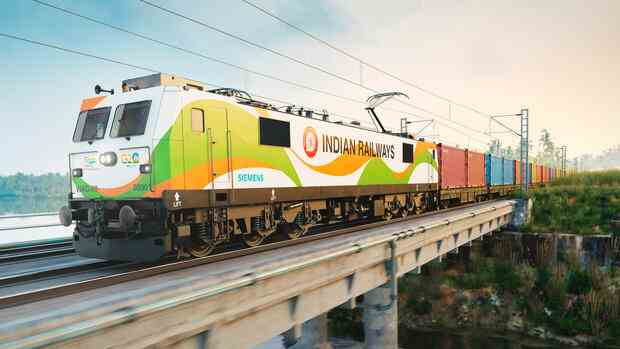The state railway company has ordered 1,200 locomotives from the technology group.
(Photo: Siemens)
Munich Siemens has received the largest single order for locomotives in the company’s history. The Indian state railway company Indian Railways has ordered 1,200 electric locomotives from the German technology group. Including service, the contract has a volume of three billion euros.
“This is a great order to expand our footprint in the Asian market,” said Michael Peter, CEO of Siemens Mobility, to the Handelsblatt after signing the contract. So far, the people of Munich have mainly been active in the region with signaling technology and local transport.
India, with its fast-growing economy, represents great hope for rail technology providers, as it does for many other industries. The rail network, at around 70,000 kilometers, is one of the longest in the world. According to the UIC industry association, Indian Railways recently covered more than a thousand billion passenger kilometers a year.
$1.3 million per locomotive
The Indian state has initiated massive investments in recent years and has almost completely electrified the route network. In previous years, however, tenders often dragged on. There were opaque procedures and wrangling over competences.
Top jobs of the day
Find the best jobs now and
be notified by email.
According to industry circles, this has at least partially improved and Siemens Bahntechnik boss Peter is hoping for further major orders: “India is investing massively in the expansion of the railway infrastructure and modern trains.” There are other tenders, for example for more powerful locomotives, in which Siemens Mobility is involved will.
The nine thousand hp locomotives that have now been ordered are to be delivered over a period of eleven years. Construction will take place at an Indian Railways factory in Dahod. A production model of this type already existed in Europe, said Peter. It has the advantage that Siemens does not have to invest as much capital as it would to set up its own production.
The locomotives are to be used in India for freight transport. According to industry circles, Siemens demanded 1.33 million dollars per locomotive, competitor Alstom was a million more. However, the overall package also includes the often lucrative services.
Peter did not want to comment on these numbers. The tender was fair and transparent. “We submitted a competitive offer. Of course there is price pressure, and the cheapest wins.” Expected returns are no different than with other train projects. You earn money with both the locomotives and the service.
The volume of orders is growing worldwide
According to Peter, the tender in India follows a trend: “The projects are getting bigger worldwide.” In many places there are state investment programs after Corona, and entire train fleets are often renewed.
Among other things, Siemens Mobility recently delivered the ICE 3 neo to Deutsche Bahn. The railway technology division increased sales in the 2021/22 financial year by a comparable three percent to almost 9.7 billion euros. The operating margin also deteriorated from 9.2 to 8.2 percent due to delivery delays in the wake of the corona pandemic.
First of all, the prospects are good. Mobility can process an order backlog of 36 billion euros in the next few years. Another major order from Egypt is on the horizon for the current financial year.
The industry is generally in a positive mood after a small Corona sag. Krzysztof Mamiński, President of the World Union UIC, said rail transport “must play a leading role in the decarbonization of the transport sector worldwide. However, the industry must improve its cost efficiency through innovation and digitization.
The European industry association Unife expects that the world market will grow by an average of three percent a year to 210 billion euros by 2027. Almost a third of this is accounted for by the trains themselves, the rest mainly by infrastructure and service.
For Siemens and the other providers, digitization is the big issue. A few years ago, there was repeated speculation that the group could separate itself from railway technology and focus entirely on software and digital business. Ex-boss Joe Kaeser wanted to merge Mobility with Alstom, but the project failed due to resistance from the antitrust authorities.
Mobility is now considered a core component of the newly established Siemens AG. CEO Roland Busch emphasizes again and again that no company can connect the real and the digital world as well as Siemens. Trains, which deliver large amounts of data during operation today, are a good example of this.
More: Mercedes expects double-digit sales growth in India

